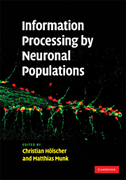
Research in the area of neuroscience and brain functions has made extraordinary progress in the last 50 years, in particular with the advent of novel methods that enables us to look at the properties of neuroanatomy and neurophysiology in much finer detail, and even at the activity of living brains during the performance of tasks. However, the question of how information is actually represented and encoded by neurons is still one of the "final frontiers" of neuroscience, and surprisingly little progress has been made here. How information is encoded in the brain has captivated medics, scientists, and philosophers for centuries. Scholars such as Leonardo da Vinci or René Descartes had already an astonishingly detailed knowledge of the anatomy of the brain, and had made suggestions that it is the brain that processes information and even harbors the seat of the personality or of the soul. However, whenever suggestions are brought forward how information might be processed and represented in the brain, these often turn out to be simplistic and idealistic. These rarely add up tomore than a kind of "homunculus" that somehow receives information that is received via the eyes or the ears. This model only transfers the problem of information representation from the brain to the homunculus. One problem with the research of information encoding is that it is completely counter-intuitive. Often it is very helpful to explain complex anatomical and functional processeswith mental images or sketches that compare a difficult, unknown process withobjects and machines of everyday use that people can easily picture. Unfortunately, it is impossible to do so with the topic of information encoding without ending up with comparisons that convey a completely wrong message. In the past, the brain had been compared to machines that were in use at the time, e.g.Descartes compared the nervous system to water pipeline networks that convey information via liquid-filled tubes to the brain ventricles, where the information is gathered and presented to the pineal gland, the proposed seat of the soul. Later, the brain had been compared to a telephone exchange, with information arriving from the outside at the "central switchboard" where it is processed, and leaving the brain through outgoing lines. More recently, the brain hasbeen compared to a computer. However, none of these images actually really explains how the brain processes information, since the architecture and the actual algorithms that govern information processing in neuronal populations are completely different from a computer that runs a piece of software on a silicon chip. The reason for this is based in the very counter-intuitive process of translating information about the real world (e.g. the color of a plant) into abstract symbols or codes that have nothing in common with the original information. It is difficult to explain to the lay person that a digital camera translates an image into rows of zeroes and ones. These rows encode the information "somehow" and can be translated again by a monitor or a printer into a two-dimensional picture that we can "understand." It is impossible to grasp intuitively where the information of the picture is located in the string of zeroes and ones. In a similar fashion, it will not be possible to provide an intuitivemodel of how information about the real world is encoded in neuronal activity. Neuronal activity consists of discrete "digital" states such as action potentials, but also encompasses analogue states of membrane potentials on dendrites and cell bodies. Any model that wants to explain neuronal encoding of information will have to work within these parameters. In the 1930s, techniques became available that permitted to record the activity of single neurons, and of large brain areas (electroencephalograms, EEGs). This very much formed and influenced the models and concepts developed in those times. The main concepts that were emphasized then were the models of information coding in neurons by rate coding. Even though several other mathematical concepts and network models did exist back then, the available techniques did not provide any data that could be used to underpin such models. With the development of single-cell recording in freely moving animals it became possible to actually observe neurons during the process of information processing and storage. The data of single-cell recording had been mainly interpreted in the traditional view that neurons code information by modulating firing rates. In parallel, large-scale activity of brain areas became observable with the development of PET scan technology.
- ISBN: 978-0-521-87303-1
- Editorial: Cambridge University
- Encuadernacion: Cartoné
- Páginas: 471
- Fecha Publicación: 31/12/2008
- Nº Volúmenes: 1
- Idioma: Inglés
